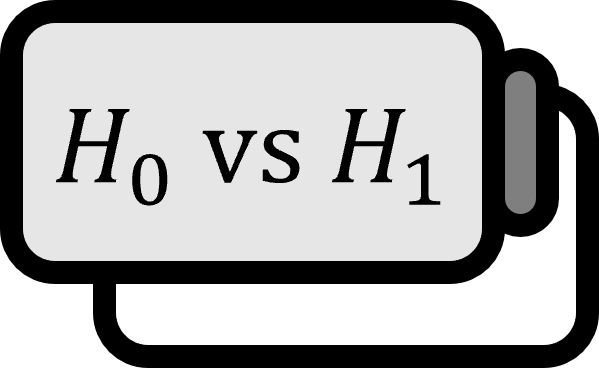Hypothesis Testing for the Population Mean with a Small Sample
Hypothesis Testing 1
Assuming the population distribution follows a normal distribution $N \left( \mu , \sigma^{2} \right)$ but the population variance $\sigma^{2}$ is unknown. When the sample size is $n < 30$, a small sample, the hypothesis test about the candidate $\mu_{0}$ for the population mean proceeds as follows.
- $H_{0}$: $\mu = \mu_{0}$. That is, the population mean is $\mu_{0}$.
- $H_{1}$: $\mu \ne \mu_{0}$. That is, the population mean is not $\mu_{0}$.
test statistic
The test statistic uses the sample standard deviation $s$ as follows: $$ t = {{ \overline{X} - \mu_{0} } \over { s / \sqrt{n} }} $$
Explanation
Essentially, this is no different from the hypothesis testing for population mean with a large sample, but it can be used even with a small sample provided that the population’s normality is assumed. Fortunately, the t-distribution is not significantly affected by the sample size, and thus the statistic $t$ is called robust. Regardless of the mathematical derivation process, in practice, the changes are not significant even if the population’s normality is somewhat lacking.
Derivation
Per Student’s theorem: Assuming that random variables $X_{1} , \cdots , X_{n}$ are iid and follow a normal distribution $N\left( \mu,\sigma^{2} \right)$
- (a): $$ \overline{X} \sim N\left( \mu , { {\sigma^2} \over {n} } \right) $$
- (b): $$ \overline{X} \perp S^2 $$
- (c): $$ (n-1) { {S^2} \over {\sigma^2} } \sim \chi^2 (n-1) $$
- (d): $$ T = { {\overline{X} - \mu } \over {S / \sqrt{n}} } \sim t(n-1) $$
According to Student’s theorem, the test statistic $t$ exactly follows a t-distribution with the degrees of freedom $(n-1)$. Given a random variable $Y$ that follows a t-distribution $t(n-1)$, for a significance level $\alpha$, $H_{0}$ is rejected if $P \left( Y \ge t_{\alpha} \right) = \alpha$ satisfies $t_{\alpha}$. This is equivalent to saying: $$ \left| t \right| \ge t_{\alpha} $$ This means that believing $\mu = \mu_{0}$ under the null hypothesis indicates that $\overline{X}$ is too far from $\mu_{0}$.
■
Mendenhall. (2012). Introduction to Probability and Statistics (13th Edition): p399. ↩︎
